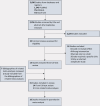Outpatient Follow-Up Visits to Reduce 30-Day All-Cause Readmissions for Heart Failure, COPD, Myocardial Infarction, and Stroke: A Systematic Review and Meta-Analysis
- PMID: 39325638
- PMCID: PMC11451567
- DOI: 10.5888/pcd21.240138
Outpatient Follow-Up Visits to Reduce 30-Day All-Cause Readmissions for Heart Failure, COPD, Myocardial Infarction, and Stroke: A Systematic Review and Meta-Analysis
Abstract
Introduction: Hospital readmissions is an important public health problem that US hospitals are responsible for reducing. One strategy for preventing readmissions is to schedule an outpatient follow-up visit before discharge. The objective of this study was to determine whether outpatient follow-up visits are an effective method to reduce 30-day all-cause readmissions for patients discharged from US hospitals with heart failure, chronic obstructive pulmonary disease (COPD), acute myocardial infarction (AMI), or stroke.
Methods: We conducted a systematic review and meta-analysis to identify relevant articles published from 2013 through 2023. We searched PubMed, CINAHL, and Cochrane. Eligible studies were those that assessed the effect of postdischarge outpatient follow-up visits on 30-day all-cause readmission. We used random effect meta-analyses to generate pooled adjusted effect estimates and 95% CIs.
Results: We initially identified 2,256 articles. Of these, 32 articles underwent full-text review and 15 met inclusion criteria. Seven studies addressed heart failure, 3 COPD, 2 AMI, and 3 stroke. Ten articles provided sufficient information for meta-analysis. The pooled adjusted effect measure was 0.79 (95% CI, 0.69-0.91), indicating that outpatient follow-up visits were associated with a 21% lower risk of readmission. However, we found a high degree of between-study heterogeneity (Q = 122.78; P < .001; I2 = 92.7%). Subgroup analyses indicated that study quality, disease condition, and particularly whether a time-dependent analysis method was used, explained much of the heterogeneity.
Conclusion: Outpatient follow-up visits are a potentially effective way to reduce 30-day all-cause readmissions for patients discharged with heart failure or stroke, but evidence of benefit was lacking for COPD and we found no studies for assessing AMI. Our results emphasize the importance of study quality.
Figures



Similar articles
-
Pulmonary rehabilitation following exacerbations of chronic obstructive pulmonary disease.Cochrane Database Syst Rev. 2016 Dec 8;12(12):CD005305. doi: 10.1002/14651858.CD005305.pub4. Cochrane Database Syst Rev. 2016. PMID: 27930803 Free PMC article.
-
Effect of Early Follow-Up After Hospital Discharge on Outcomes in Patients With Heart Failure or Chronic Obstructive Pulmonary Disease: A Systematic Review.Ont Health Technol Assess Ser. 2017 May 25;17(8):1-37. eCollection 2017. Ont Health Technol Assess Ser. 2017. PMID: 28638496 Free PMC article.
-
Immunostimulants versus placebo for preventing exacerbations in adults with chronic bronchitis or chronic obstructive pulmonary disease.Cochrane Database Syst Rev. 2022 Nov 14;11(11):CD013343. doi: 10.1002/14651858.CD013343.pub2. Cochrane Database Syst Rev. 2022. PMID: 36373977 Free PMC article.
-
Self-management interventions including action plans for exacerbations versus usual care in patients with chronic obstructive pulmonary disease.Cochrane Database Syst Rev. 2017 Aug 4;8(8):CD011682. doi: 10.1002/14651858.CD011682.pub2. Cochrane Database Syst Rev. 2017. PMID: 28777450 Free PMC article.
-
Smoking cessation for secondary prevention of cardiovascular disease.Cochrane Database Syst Rev. 2022 Aug 8;8(8):CD014936. doi: 10.1002/14651858.CD014936.pub2. Cochrane Database Syst Rev. 2022. PMID: 35938889 Free PMC article.
Cited by
-
CEDART Study: protocol for a non-randomized feasibility study.Res Sq [Preprint]. 2025 May 13:rs.3.rs-6378596. doi: 10.21203/rs.3.rs-6378596/v1. Res Sq. 2025. PMID: 40470215 Free PMC article. Preprint.
-
Readmission Events Following EGD for Upper Gastrointestinal Bleed: An Analysis Using the National Readmission Database.Med Sci (Basel). 2025 Apr 20;13(2):45. doi: 10.3390/medsci13020045. Med Sci (Basel). 2025. PMID: 40265392 Free PMC article.
-
Healthy days at home and prognosis of older adults with cancer and non-cancer serious life-limiting illnesses.BMC Geriatr. 2025 Jul 3;25(1):487. doi: 10.1186/s12877-025-06160-9. BMC Geriatr. 2025. PMID: 40610903 Free PMC article.
-
Ready to Go, But Not Alone: Why Post-Discharge Follow-Up Defines Hospital Length of Stay.Cureus. 2025 Jun 27;17(6):e86864. doi: 10.7759/cureus.86864. eCollection 2025 Jun. Cureus. 2025. PMID: 40718247 Free PMC article. Review.
-
Pragmatic Risk Stratification Method to Identify Emergency Department Presentations for Alternative Care Service Pathways: Registry-Based Retrospective Study Over 5 Years.J Med Internet Res. 2025 May 12;27:e73758. doi: 10.2196/73758. J Med Internet Res. 2025. PMID: 40354643 Free PMC article.
References
-
- Weiss AJ, Jiang HJ. Overview of clinical conditions with frequent and costly hospital readmissions by payer, 2018. Statistical brief #278. Healthcare Cost and Utilization Project. Agency for Healthcare Research and Quality. July 2021. Accessed June 1, 2024. https://hcup-us.ahrq.gov/reports/statbriefs/sb278-Conditions-Frequent-Re... - PubMed
-
- McDermott KW, Roemer M. Most frequent principal diagnoses for inpatient stays in U.S. hospitals, 2018. Statistical brief #277. Healthcare Cost and Utilization Project. Agency for Healthcare Research and Quality. July 2021. Accessed June 1, 2024. https://hcup-us.ahrq.gov/reports/statbriefs/sb277-Top-Reasons-Hospital-S... - PubMed
Publication types
MeSH terms
LinkOut - more resources
Full Text Sources
Medical
Miscellaneous

